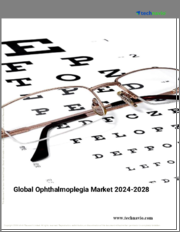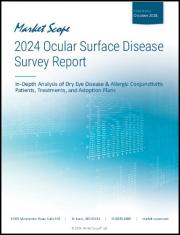
|
시장보고서
상품코드
1352175
세계의 안와 위축증 시장(2023-2030년)Global Foveal Atrophy Market - 2023-2030 |
||||||
개요
안와 위축증 시장은 고령화, 기술 발전, 연구 개발의 발전, 환자 인식 및 교육, 규제 당국의 승인과 같은 요인에 의해 주도되고 있습니다.
작고 국소적이고, 경계가 명확하지 않고, 색소 침착이 얇은 포사동 병변 또는 쐐기형 포사동 병변이 존재하는 반면 망막의 다른 부분은 손상되지 않은 경우 안와 위축증이라고합니다. 중심와라고도 불리는 중심와, 신경감각망막의 작은 움푹 들어간 부분으로, 시력이 가장 높습니다.
수많은 황반, 혈관, 유전, 염증, 독성, 외상성 망막 질환은 모두 안와위축증을 동반할 수 있습니다. 일반적으로 노화성 황반변성, 근시성 황반변성, 혈관근, 장기 낭포성 황반부종, 황반변성 등 일반적인 지리적 위축으로 나뉩니다.
또 다른 망막 질환으로 인한 황반 위축이라고도 합니다. 황반 광독성 및 중심성 장액맥락망막병증과 같은 일부 망막 질환에서 위축은 일반적으로 작은 병변으로 나타납니다. 위축은 때때로 포와부나 쐐기형 포와부에 발생할 수 있습니다.
시장 역학
연구활동 활성화로 세계 안와위축증 시장 성장 견인
중심장액맥락망막병증(CSC) 환자에게 광선역학적 치료(PDT)를 반량 투여한 결과, 구조적, 기능적으로 유리하며, 중심장액맥락망막병증 환자에게는 안와위축증이 발생하지 않았습니다. 만성 CSC 환자 57명을 대상으로 안와를 치료 부위로 하여 1회 반량 PDT를 시행하고 있습니다.
기준선 및 치료 후 몇 차례의 진료에서 빛간섭단층촬영과 안저자발형광 영상을 통해 구조적 개선과 위축 발생 가능성을 조사했습니다. 조사 결과, 광간섭 단층 촬영에서 외측 경계막과 타원형 영역의 완전성, 안저 자발적 형광에서 낮은 자기 형광이 1차 평가 항목이었습니다.
인구 고령화, 세계 안와위축증 시장 성장 촉진
노화, 특히 노화성 황반변성(AMD)의 경우, 안와위축증의 발병과 진행은 노화의 영향을 크게 받습니다. 나이가 들어감에 따라 AMD와 안와 위축증이 발생할 가능성이 크게 증가하며, 50세 이상이면 AMD 발병 위험이 크게 증가하며, 그 위험은 나이가 들어감에 따라 계속 증가합니다. 이는 눈의 자연적인 노화 과정으로 인해 눈이 쉽게 손상되고 악화되기 때문입니다.
세포의 변화와 망막을 포함한 여러 조직에 해를 끼치는 것은 노화 현상의 일부입니다. 이는 결국 황반부 세포의 건강과 기능에 영향을 미쳐 안와 위축증을 유발할 수 있습니다.
안와위축증으로 인한 세계 안와위축증 시장 성장 저해
안와위축증 치료법은 개선되고 있지만, 안와위축증을 유발하는 AMD, 스타가르트병 등의 질환은 아직 치료법이 확립되어 있지 않습니다. 이는 환자의 선택권을 제한하고 시장 확대를 지연시킬 수 있습니다. 항VEGF 주사는 비용이 많이 들고 자주 시행해야 하는 치료법 중 하나입니다. 특히 의료 접근성이 낮은 지역에서는 특정 환자들의 치료 접근성이 제한될 수 있습니다. 안와위축증은 AMD와 같은 다인성 복합 질환으로 인해 발생하는 경우가 많습니다. 근본적인 문제를 해결할 수 있는 집중적인 약물을 만드는 것은 어려울 수 있습니다.
목차
제1장 조사 방법과 조사 범위
제2장 정의와 개요
제3장 주요 요약
제4장 시장 역학
- 영향요인
- 성장 촉진요인
- 성장 억제요인
- 기회
- 기술 진보
- 영향 분석
제5장 산업 분석
- Porter의 Five Forces 분석
- 공급망 분석
- 미충족 요구
- 규제 분석
제6장 COVID-19 분석
제7장 러시아·우크라이나 전쟁 분석
제8장 인공지능 분석
제9장 유형별
- 포도막성 안와 위축증
- 국소성 안와 위축증
제10장 약제 클래스별
- 항VEGF 요법
- 유전자 치료
- 기타
제11장 최종사용자별
- 안과 클리닉
- 병원
- 연구기관
제12장 지역별
- 북미
- 미국
- 캐나다
- 멕시코
- 유럽
- 독일
- 영국
- 프랑스
- 이탈리아
- 스페인
- 기타 유럽
- 남미
- 브라질
- 아르헨티나
- 기타 남미
- 아시아태평양
- 중국
- 인도
- 일본
- 호주
- 기타 아시아태평양
- 중동 및 아프리카
제13장 경쟁 구도
- 경쟁 시나리오
- 제품 벤치마킹
- 기업 점유율 분석
- 주요 발전과 전략
제14장 기업 개요
- Novartis AG
- 기업 개요
- 제품 포트폴리오와 설명
- 재무 개요
- 주요 동향
- Regeneron Pharmaceuticals
- Genetech
- AbbVie
- Others
제15장 부록
LSH 23.10.17Overview
The Foveal atrophy market is driven by factors such as the aging population, advances in technology, increasing research and development, patient awareness and education, and regulatory approvals.
A small, focal, poorly defined, hypopigmented foveal or juxtafoveal lesion is referred to as focal foveal atrophy when it is present but the rest of the retina is unharmed. The fovea centralis, often known as the fovea, is a tiny depression located in the neurosensory retina that has the best visual acuity. The macula's fovea, which is in the center and is responsible for central vision, is by itself.
Numerous macular, vascular, genetic, inflammatory, toxic, and traumatic retinal illnesses can all be accompanied by foveal atrophy. It is typically categorized under the general heading of geographic atrophy in people with age-related macular degeneration, myopic degeneration, angioid streaks, long-term cystoid macular edema from any source, and macular dystrophies.
It is also sometimes referred to as macular atrophy due to other retinal illnesses. In some retinal illnesses, such as macular phototoxicity and resolved central serous chorioretinopathy, atrophy typically manifests as a tiny lesion. Atrophy can occasionally develop in the foveal or juxtafoveal area.
Market Dynamics
The Increasing Research Activities are Driving the Global Foveal Atrophy Market Growth
One application of half-dose photodynamic treatment (PDT) targeting the fovea was found to be structurally and functionally advantageous for treating individuals with chronic central serous chorioretinopathy (CSC), and they did not experience foveal atrophy. A single half-dose PDT with a treatment location that included the fovea was administered to a total of 57 patients with chronic CSC.
At baseline and numerous visits after therapy, optical coherence tomography scans and fundus autofluorescence images were examined for structural improvement and potential atrophic development. According to researchers, the external limiting membrane and ellipsoid zone integrity on optical coherence tomography, as well as hypoautofluorescence on fundus autofluorescence, were the primary outcome measures.
The Aging Population Boost the Global Foveal Atrophy Market Growth
The development and progression of foveal atrophy are significantly influenced by the aging population, particularly in the context of age-related macular degeneration (AMD). With age, the likelihood of developing AMD and foveal atrophy greatly rises. Over the age of 50, there is a significant increase in the risk of having AMD, and the risk keeps rising with age. This is due to the fact that the eyes' natural aging process renders them more vulnerable to harm and deterioration.
Cellular changes and accumulative harm to several tissues, including the retina, are part of the aging process. This may eventually have an effect on the health and functionality of the cells in the macula, causing foveal atrophy.
Challenges with Foveal Atrophy are Hampering the Global Foveal Atrophy Market Growth
Although there have been improvements in the ways that foveal atrophy can be treated, illnesses like AMD or Stargardt disease, which cause foveal atrophy, still have no known cure. This may restrict patients' alternatives and slow market expansion. Anti-VEGF injections are one example of a therapy option that might be costly and may need to be administered frequently. For certain patients, especially in areas with insufficient healthcare coverage, this may limit their access to treatment. Foveal atrophy frequently results from multifactorial, complicated diseases like AMD. It can be difficult to create focused medicines that go at the root problems.
Segment Analysis
The global foveal atrophy market is segmented based on type, drug class, treatment, end-user and region.
The Pharmacological Interventions Segment is Expected to Hold a Dominant Position in the Market Over the Forecast Period
The pharmacological interventions segment accounted for the highest market stake accounting for approximately 41.2% of the foveal atrophy market in 2022. Pharmacological interventions, which include those that deal with disorders like age-related macular degeneration (AMD) and stargardt disease that cause foveal atrophy, refer to the use of pharmaceuticals and treatments to treat a variety of illnesses. Wet AMD, a type of AMD characterized by aberrant blood vessel formation beneath the retina, is commonly treated with anti-VEGF (vascular endothelial growth factor) medication.
These aberrant blood arteries can cause bleeding and leakage, which exacerbates foveal atrophy. Anti-VEGF medications are injected into the eye to stop the development of these vessels, lessen leaking, and stop the disease's progression. Ranibizumab, aflibercept, and bevacizumab are typical anti-VEGF medications.
Geographical Penetration
North America Holds a Dominant Position in the Global Foveal Atrophy Market
North America is estimated to hold around 1/3rd of the total market share throughout the forecast period. Due to longer life expectancies and the aging baby boomer generation, the United States is quickly aging. Age-related eye disorders including age-related macular degeneration (AMD), which can cause foveal atrophy, are more common as people get older.
The United States has a strong healthcare system with cutting-edge medical equipment, research centers, and therapeutic alternatives. This encourages the early recognition, evaluation, and management of disorders such as foveal atrophy.
Competitive Landscape
The major global players in the market include: Novartis AG, Regeneron Pharmaceuticals, Genetech, AbbVie among others.
COVID-19 Impact Analysis
Russia-Ukraine Conflict Analysis
The Russia-Ukraine war may affect the foveal atrophy market due to a lack of facilities being impacted during times of geopolitical instability and economic uncertainty. The infrastructure and healthcare systems in affected areas can be strained by conflict and war. Emergency medical demands may have taken priority over healthcare, especially the treatment of disorders like foveal atrophy that affect the eyes.
Artificial Intelligence Analysis:
Artificial intelligence (AI) is increasingly being used in the foveal atrophy market to improve various aspects of drug development. AI-driven simulations and data analysis can hasten the development of new foveal atrophy drugs. In order to develop new therapeutics, AI systems can forecast how prospective treatments would impact retinal cells.
By Type
- Uveitic Foveal Atrophy
- Focal Foveal Atrophy
By Drug class
- Anti-VEGF Therapy
- Gene Therapy
- Others
By Treatment
- Pharmacological Interventions
- Surgical Interventions
By End-user
- Ophthalmology Clinics
- Hospitals
- Research Institutions
By Region
- North America
- U.S.
- Canada
- Mexico
- Europe
- Germany
- UK
- France
- Italy
- Spain
- Rest of Europe
- South America
- Brazil
- Argentina
- Rest of South America
- Asia-Pacific
- China
- India
- Japan
- Australia
- Rest of Asia-Pacific
- Middle East and Africa
Why Purchase the Report?
- To visualize the global foveal atrophy market segmentation based on the type, drug class, treatment, end-user and region and understand key commercial assets and players.
- Identify commercial opportunities by analyzing trends and co-development.
- Excel data sheet with numerous data points of foveal atrophy market-level with all segments.
- PDF report consists of a comprehensive analysis after exhaustive qualitative interviews and an in-depth study.
- Product mapping available as Excel consisting of critical products of all the major players.
The global foveal atrophy market report would provide approximately 61 tables, 57 figures, and 195 Pages.
Target Audience 2023
- Manufacturers/ Buyers
- Industry Investors/Investment Bankers
- Research Professionals
- Emerging Companies
Table of Contents
1. Methodology and Scope
- 1.1. Research Methodology
- 1.2. Research Objective and Scope of the Report
2. Definition and Overview
3. Executive Summary
- 3.1. Snippet by Type
- 3.2. Snippet by Drug Class
- 3.3. Snippet by Treatment
- 3.4. Snippet by End-user
- 3.5. Snippet by Region
4. Dynamics
- 4.1. Impacting Factors
- 4.1.1. Drivers
- 4.1.1.1. Aging population
- 4.1.2. Restraints
- 4.1.2.1. Challenges associated with Foveal Atrophy
- 4.1.3. Opportunity
- 4.1.3.1. Technological advancements
- 4.1.4. Impact Analysis
- 4.1.1. Drivers
5. Industry Analysis
- 5.1. Porter's 5 Forces Analysis
- 5.2. Supply Chain Analysis
- 5.3. Unmet Needs
- 5.4. Regulatory Analysis
6. COVID-19 Analysis
- 6.1. Analysis of COVID-19
- 6.1.1. Scenario Before COVID-19
- 6.1.2. Scenario During COVID-19
- 6.1.3. Scenario Post COVID-19
- 6.2. Pricing Dynamics Amid COVID-19
- 6.3. Demand-Supply Spectrum
- 6.4. Government Initiatives Related to the Market During the Pandemic
- 6.5. Manufacturers' Strategic Initiatives
- 6.6. Conclusion
7. Russia-Ukraine War Analysis
8. Artificial Intelligence Analysis
9. By Type
- 9.1. Introduction
- 9.1.1. Market Size Analysis and Y-o-Y Growth Analysis (%), By Type
- 9.1.2. Market Attractiveness Index, By Type
- 9.2. Uveitic Foveal Atrophy*
- 9.2.1. Introduction
- 9.2.2. Market Size Analysis and Y-o-Y Growth Analysis (%)
- 9.3. Focal Foveal Atrophy
10. By Drug Class
- 10.1. Introduction
- 10.1.1. Market Size Analysis and Y-o-Y Growth Analysis (%), By Drug Class
- 10.1.2. Market Attractiveness Index, By Drug Class
- 10.2. Anti-VEGF Therapy*
- 10.2.1. Introduction
- 10.2.2. Market Size Analysis and Y-o-Y Growth Analysis (%)
- 10.3. Gene Therapy
- 10.4. Others
11. By End-user
- 11.1. Introduction
- 11.1.1. Market Size Analysis and Y-o-Y Growth Analysis (%), By End-user
- 11.1.2. Market Attractiveness Index, By End-user
- 11.2. Ophthalmology Clinics*
- 11.2.1. Introduction
- 11.2.2. Market Size Analysis and Y-o-Y Growth Analysis (%)
- 11.3. Hospitals
- 11.4. Research Institutions
12. By Region
- 12.1. Introduction
- 12.1.1. Market Size Analysis and Y-o-Y Growth Analysis (%), By Region
- 12.1.2. Market Attractiveness Index, By Region
- 12.2. North America
- 12.2.1. Introduction
- 12.2.2. Key Region-Specific Dynamics
- 12.2.3. Market Size Analysis and Y-o-Y Growth Analysis (%), By Type
- 12.2.4. Market Size Analysis and Y-o-Y Growth Analysis (%), By Drug Class
- 12.2.5. Market Size Analysis and Y-o-Y Growth Analysis (%), By Treatment
- 12.2.6. Market Size Analysis and Y-o-Y Growth Analysis (%), By End-user
- 12.2.7. Market Size Analysis and Y-o-Y Growth Analysis (%), By Country
- 12.2.7.1. U.S.
- 12.2.7.2. Canada
- 12.2.7.3. Mexico
- 12.3. Europe
- 12.3.1. Introduction
- 12.3.2. Key Region-Specific Dynamics
- 12.3.3. Market Size Analysis and Y-o-Y Growth Analysis (%), By Type
- 12.3.4. Market Size Analysis and Y-o-Y Growth Analysis (%), By Drug Class
- 12.3.5. Market Size Analysis and Y-o-Y Growth Analysis (%), By Treatment
- 12.3.6. Market Size Analysis and Y-o-Y Growth Analysis (%), By End-user
- 12.3.7. Market Size Analysis and Y-o-Y Growth Analysis (%), By Country
- 12.3.7.1. Germany
- 12.3.7.2. U.K.
- 12.3.7.3. France
- 12.3.7.4. Italy
- 12.3.7.5. Spain
- 12.3.7.6. Rest of Europe
- 12.4. South America
- 12.4.1. Introduction
- 12.4.2. Key Region-Specific Dynamics
- 12.4.3. Market Size Analysis and Y-o-Y Growth Analysis (%), By Type
- 12.4.4. Market Size Analysis and Y-o-Y Growth Analysis (%), By Drug Class
- 12.4.5. Market Size Analysis and Y-o-Y Growth Analysis (%), By Treatment
- 12.4.6. Market Size Analysis and Y-o-Y Growth Analysis (%), By End-user
- 12.4.7. Market Size Analysis and Y-o-Y Growth Analysis (%), By Country
- 12.4.7.1. Brazil
- 12.4.7.2. Argentina
- 12.4.7.3. Rest of South America
- 12.5. Asia-Pacific
- 12.5.1. Introduction
- 12.5.2. Key Region-Specific Dynamics
- 12.5.3. Market Size Analysis and Y-o-Y Growth Analysis (%), By Type
- 12.5.4. Market Size Analysis and Y-o-Y Growth Analysis (%), By Drug Class
- 12.5.5. Market Size Analysis and Y-o-Y Growth Analysis (%), By Treatment
- 12.5.6. Market Size Analysis and Y-o-Y Growth Analysis (%), By End-user
- 12.5.7. Market Size Analysis and Y-o-Y Growth Analysis (%), By Country
- 12.5.7.1. China
- 12.5.7.2. India
- 12.5.7.3. Japan
- 12.5.7.4. Australia
- 12.5.7.5. Rest of Asia-Pacific
- 12.6. Middle East and Africa
- 12.6.1. Introduction
- 12.6.2. Key Region-Specific Dynamics
- 12.6.3. Market Size Analysis and Y-o-Y Growth Analysis (%), By Type
- 12.6.4. Market Size Analysis and Y-o-Y Growth Analysis (%), By Drug Class
- 12.6.5. Market Size Analysis and Y-o-Y Growth Analysis (%), By Treatment
- 12.6.6. Market Size Analysis and Y-o-Y Growth Analysis (%), By End-user
13. Competitive Landscape
- 13.1. Competitive Scenario
- 13.2. Product Benchmarking
- 13.3. Company Share Analysis
- 13.4. Key Developments and Strategies
14. Company Profiles
- 14.1. Novartis AG*
- 14.1.1. Company Overview
- 14.1.2. Product Portfolio and Description
- 14.1.3. Financial Overview
- 14.1.4. Key Developments
- 14.2. Regeneron Pharmaceuticals
- 14.3. Genetech
- 14.4. AbbVie
- 14.5. Others
LIST NOT EXHAUSTIVE
15. Appendix
- 15.1. About Us and Services
- 15.2. Contact Us

















